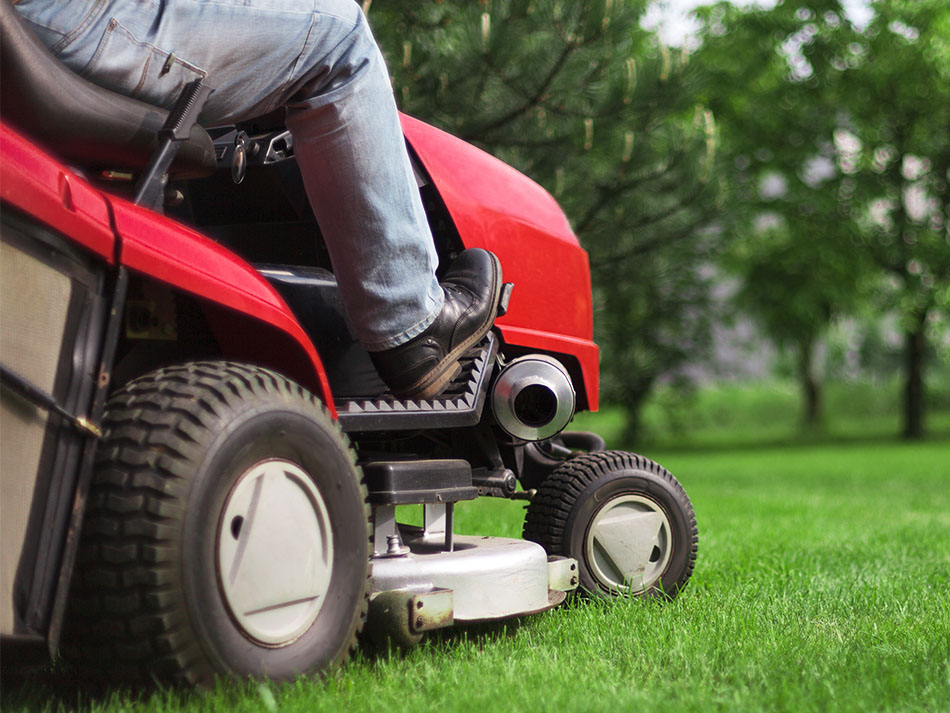Loving Your Lawn
April 30, 2023
Everyone has that neighbor with the perfect, flawless lawn. There are no weeds, every edge is trimmed to exacting standards, and it’s striped like the infield at a professional baseball stadium. It’s a beautiful sight, to be sure. You can have that lawn too with some simple feeding, watering, and mowing tips.
Fertilizing, Feeding, and Seeding
A healthy lawn is a well-fed lawn. By feeding your lawn with the right fertilizer and seed during the year, you can strengthen the root system, making it better equipped to rebound from extreme heat and cold, as well as daily use by people and pets.
From February to April, you’ll want to feed your lawn a turf-building fertilizer that includes a pre-emergent herbicide to control crabgrass and other weeds. In late spring (May), cover your lawn with a weed and feed application that feeds your lawn and kills off broadleaf weeds. Come summer, you’ll want to eliminate insects that can kill your lawn. In the fall give your lawn everything it needs to thrive over the winter with a lawn food rich in nitrogen. This will help your lawn maintain a healthy green next spring. Additionally, reseed your lawn to encourage new growth in the spring.
Eliminating Weeds
Sure, you can get on all fours and yank the weeds from your lawn, but unless you get every bit of the roots, those weeds will just grow back bigger and madder. To get that professional-looking lawn, use a weed control spray or feed that targets weeds and not lawns. Your back will thank you and your lawn will reward you. To help discourage new weeds, work toward deeper root growth with specific watering.
Proper Watering
Some parts of the Northwest get plenty of rain throughout the year. But to maintain the perfect lawn, you’re going to need to supplement with your own water in the hot, summer months.
It’s best to water your lawn early in the morning, ideally before 10 AM. Watering at night can invite fungus to take over your lawn. Watering in the middle of the day is a waste of water.
Besides feeding your lawn, watering should also encourage deep root growth. To achieve deeper roots, simply pick two days a week to water your lawn. Then water for up to 30 minutes each of those days. You want to evenly water your lawn with approximately .5” of water. To measure how much you water, use a rain gauge at different areas of your lawn. You may find that you need to increase or decrease the time allotted to watering each day. You can also use an empty tuna can to measure water usage.
Mowing
Everyone has their own method of mowing. Some subscribe to the round-and-round technique, while others prefer the straight-line approach. Then, there are those who like the ballpark look, which is really pretty simple to achieve.
The ballpark effect is achieved when the blades of grass are bent over. The ones that look darker are bent toward the viewer, while the lighter lines are blades of grass that are bent away.
To get those light and dark lines, adjust your mower to a higher setting and mow your lawn in your desired pattern (straight lines, checkerboard, etc.). Bonus: mowing at a higher setting keeps weeds out and retains water in the summer months. Now that you’re done mowing, go back over your lawn with a lawn roller or other device that can bend your grass blades slightly. Be sure to follow your original mowing pattern.
Coastal has everything you need to grow and maintain the perfect lawn, from fertilizers and weed control to lawnmowers and other yard maintenance equipment. Stop by your local store and let the folks at Coastal answer your lawn care questions today.
Quick Lawn Care Guide
Winter
- Dormant
Early Spring
- Fertilizer: turf building and pre-emergent herbicide
- Weed Killer: whole lawn application
Late Spring
- Fertilizer: weed and feed
- Water: max 2 times per week for 30 minutes
Summer
- Fertilizer: insect repellent/killer
- Weed Killer: spot spray only
- Water: max 2 times per week for 30 minutes
Fall
- Fertilizer: nitrogen
- Seeding: whole lawn application
Fun Facts
- There are roughly 21-million acres of household lawns in the U.S.
- The average size lawn can produce three times more oxygen than trees while effectively absorbing a vast amount of carbon dioxide and other toxins from the air.
- Grass is an essential element for several of today’s most popular sports, including golf, tennis, baseball, soccer, football, and Lacrosse.
